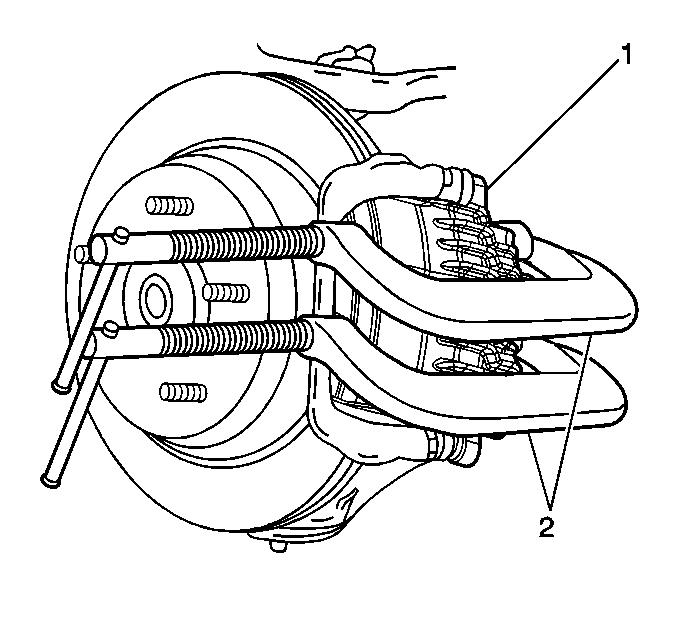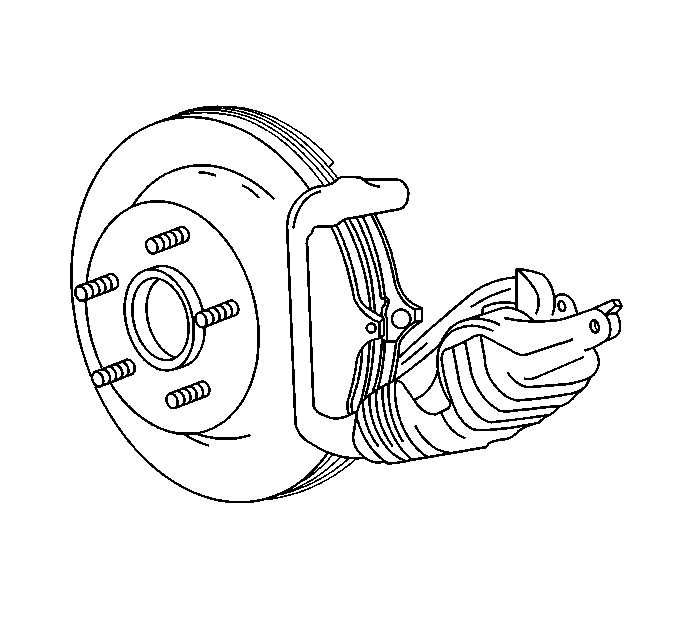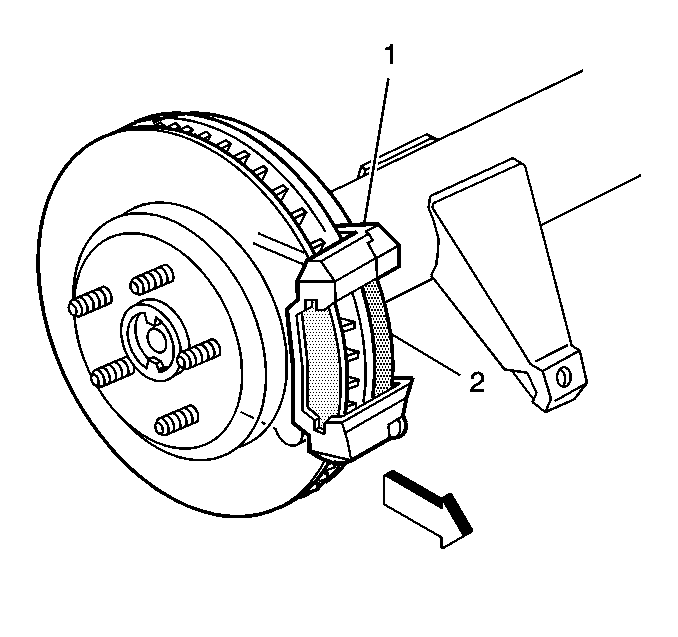Brake Pads Replacement Front
Removal Procedure
- Remove two-thirds of the brake fluid from the master cylinder reservoir.
- Raise and suitably support the vehicle. Refer to Lifting and Jacking the Vehicle .
- Remove the tire and wheel assembly. Refer to Wheel Removal .
- Install a C-clamp onto the front brake caliper and tighten until the caliper pistons bottom in the caliper housing. Verify that the C-clamp is centrally positioned on both the caliper housing and the brake pad. This provides an even clamping force on both pistons and should prevent the pistons from becoming wedged in their bores due to uneven clamping force.
- Remove front brake caliper. Refer to Brake Caliper Replacement
- Remove the inner and outer brake pads from the caliper mounting plate.
- Inspect the caliper guide pins for free movement in the caliper mounting plate.
- Inspect the caliper guide pin boots for proper seating in the retaining groove of the caliper guide pin and the rear caliper mounting plate.
- Replace the caliper guide pins and/or guide pin boots if any of the following conditions exist:

Use a screwdriver if necessary to remove the pads from their installed position.
| • | Excessive Corrosion |
| • | Excessive Wear |
| • | Visible Damage |
Installation Procedure
Important: Use GM replacement brake pads for all GM vehicles in order to maintain the balance in performance between the front and rear brakes. GM replacement brake parts are carefully selected in order to guarantee minimum stopping distance and maximum controllability over the full range of operating conditions. Installing front or rear brake pads not recommended by GM may change the intended performance, wear characteristics, and brake balance of the vehicle.
- Install the inner and outer pads into the caliper mounting plate.Ensure that the wear sensor is at the trailing edge of the outer brake pad when the wheel is rotating forward. If the wear sensor is not at the trailing edge, the outer brake pad is on the wrong side.
- Install the front brake caliper. Refer to Brake Caliper Replacement
- Install the caliper mounting pin bolts.
- With the engine running, pump the brake pedal slowly and firmly until the inner and outer brake pads are positioned against rotor (firm pedal).
- Install the tire and wheel assembly. Refer to Wheel Removal
- Lower the vehicle. Refer to Lifting and Jacking the Vehicle
- Refill the master cylinder to the proper level with clean, fresh brake fluid.
- Inspect the hydraulic brake system for brake fluid leaks.
- Burnish the new pads. Refer to Brake Pad and Rotor Burnishing in this section.

Notice: Use the correct fastener in the correct location. Replacement fasteners must be the correct part number for that application. Fasteners requiring replacement or fasteners requiring the use of thread locking compound or sealant are identified in the service procedure. Do not use paints, lubricants, or corrosion inhibitors on fasteners or fastener joint surfaces unless specified. These coatings affect fastener torque and joint clamping force and may damage the fastener. Use the correct tightening sequence and specifications when installing fasteners in order to avoid damage to parts and systems.
Tighten
Tighten the mounting pin bolts to 31 N·m (23 lb ft).
Brake Pads Replacement Rear
Removal Procedure
- Remove two-thirds of the brake fluid from the master cylinder.
- Raise and suitably support the vehicle. Refer to Lifting and Jacking the Vehicle
- Remove the tire and wheel. Refer to Wheel Removal
- Install two wheel nuts in order to retain the rotor.
- Position a C-clamp (2) over the caliper housing (1).
- Tighten the C-clamp until the caliper piston bottoms in the base of the brake caliper.Verify that one end of the C-clamp rests on the brake hose fitting bolt/screw and the other end rests against the outer pad.
- Remove the rear brake caliper from the mounting plate. Refer to Brake Caliper Replacement Ensure that weight of caliper is adequately supported.
- Remove the inner and outer brake pads (2) from the mounting plate (1).
- Clean all the residue from the shoe guide surfaces on the caliper mounting plate and the rear brake caliper.
- Inspect the caliper guide pins for free movement in the caliper mounting plate.
- Inspect the caliper guide pin boot for proper seating in the retaining groove of the guide pin and the caliper mounting plate.Replace the caliper guide pins or the guide pin boots, if corrosion or damage exists. Refer to Brake Caliper Overhaul


Installation Procedure
- Install new inner and outer pads (2) into mounting plate (1).
- Install the rear brake caliper to the mounting plate. Refer to Brake Caliper Replacement
- Remove the wheel nuts securing the rotor.
- Install the tire and wheel. Refer to Wheel Removal
- Lower the vehicle.
- With engine running, pump brake pedal until brake pads are positioned against rotor (firm brake pedal).
- Verify that there are no leaks in the brake hydraulic system.
- Burnish the new pads. Refer to Brake Pad and Rotor Burnishing in this section.

Important:
• Install the inner pad with wear sensor near the piston. • Ensure that the wear sensor is on the leading edge of the inner
pad during forward wheel rotation. If the wear sensor is not on the leading
edge, use the other inner pad in the replacement kit. • Replace the inner and outer pads in axle sets only.
